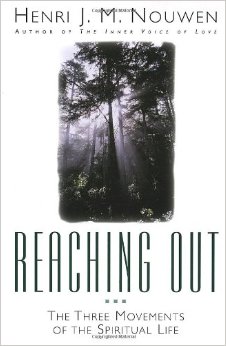
Last week, I began blogging through the first section of Henri Nouwen‘s Reaching Out: The Three Movements of the Spiritual Life (to read the first post click here). The first movement – from loneliness to solitude – struck a chord within me, as I reflected that graduate school can be a lonely time and place for many people. Of course, loneliness can strike at any time and any place. Loneliness is even independent of the number of people you’re with.
Solitude of Heart
What’s the cure for loneliness? Solitude. But Nouwen stresses that solitude does not mean being alone, though retreat has been and continues to be a crucial part of developing the discipline of solitude. Just as you can be lonely while surrounded by people, you can be completely alone, yet lack solitude.
…the solitude that really counts is the solitude of heart; it is an inner quality or attitude that does not depend on physical isolation…It seems more important than ever to stress that solitude is one of the human capacities that can exist, be maintained and developed in the center of a big city, in the middle of a large crowd and in the context of a very active and productive life. A man or woman who has developed this solitude of heart is no longer pulled aprt by the most divergent stimuli of the surrounding world but is able to perceive and understand this world from a quiet inner center. (25)
Nouwen goes on to hold up the Trappist monk Thomas Merton as an example of someone who was able to practice solitude in the midst of a busy world, even being drawn deeper into involvement with the world as his solitude developed.
Solitude in Community
Ironically, when we seek to connect with other people from a position of loneliness, hoping that our relationship with them with satisfy us, we are left even more lonely than when we began. At the beginning of my sophomore year in college, I ended a string of bad romantic relationships that had all ended with either me seeking more than the other person could give, or rejecting someone who was asking me for more than I was willing to give her. I had a moment of clarity one morning and vowed never again to press a relationship further than the other person wanted – if she only wanted to be friend, fine, that’s what we would be. It wasn’t worth the pain to seek more. I think it was later that week that I met my future wife, but it took me another year to realize that my relationship with her could never be enough, without a relationship with Jesus first.
At Regent College, I had the pleasure of moderating a public conversation with J. I. Packer. If you have ever heard Dr. Packer speak, you know that he answers casual questions with extemporaneous-yet-perfectly-outlined mini-lectures, so we only got through 2 questions during the hour. The second question, though, came from a person who asked whether it was true that Dr. Packer had proposed to his future-wife after only a single date.
Yes, it was true, he affirmed, and he told the story of meeting her while in graduate school and their whirlwind romance – a single date, a few months of long-distance courtship, and then engagement. He didn’t recommend such a pattern for most people, but in their case, he said it worked because
…we both knew who we were.
Nouwen titles the final section of this chapter “Community as an Inner Quality.” Individual solitude means that
the togetherness of friends and lovers can become moments in which we can enter into a common solitude which is not restricted by time and place. (31)
He continues:
We are always in search of a community that can offer us a sense of belonging, but it is important to realize that being together in one place, one house, one city or one country is only secondary to the fulfillment of our legitimate desire.
Friendship and community are, first of all, inner qualities allowing human togetherness to be the playful expression of a much larger reality. They can never be claimed, planned or organized, but in our innermost self the place can be formed where they can be received as gifts.
What’s your reaction to Nouwen’s take on friendship and community? Do you agree with this idea of “community as an inner quality”?
————-
Click here for Part 1 of the series, entitled Henri Nouwen: From Loneliness to Solitude.
Click here for Part 3 of the series, entitled Henri Nouwen: A Creative Response (from Loneliness to Solitude).
The former Associate Director for the Emerging Scholars Network, Micheal lives in Cincinnati with his wife and three children and works as a web manager for a national storage and organization company. He writes about work, vocation, and finding meaning in what you do at No Small Actors.

Nouwen was a universalist, pantheist, ecumenlicast and didn’t believe salvation was through Christ alone. “Jesus said, “I am the Way, the Truth and the Life. NO MAN comes to the Father, but by Me.” John 14:6